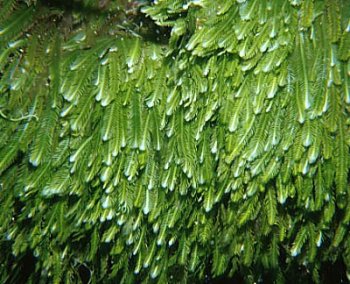As a marine
science major I decided to take a break from blogging about the Cane Toad as
much as I love reading up on the species and their effects on the ecosystem
they inhabit and instead provide an example of an invasive aquatic species. More specifically, a species that has been
introduced to both where I come from in California and her in Australia as
well.
Caulerpa taxifolia is a native algae to Hawaii. Being that this algae is a native species to
Hawaii it has not grown out of control but rather has its place within the
ecosystem providing balance.
Unfortunately the same cannot be said for areas of the Mediterranean and
California where this species has now spread (University of Hawaii 2014).

Above is a
picture to provide an example of how abundant the presence of this species can
be in areas in which it inhabits.
According to
CEPA (California Environmental Protection Agency 2014) Caulerpa, also referred to as “Killer Algae” was imported for
aquarium purposes for its particular fast growth rate of about an inch per day
and appealing appearance. It is believed
that that the “Killer Algae” began its invasion of coastal waters following an
illegal dumping of algae residue into the water ways (CEPA 2014). Caulerpa,
as most introduced species, competes for resources with the native species of
the area lacking natural predators and because of the toxin the algae produces
local herbivores are not interested (CEPA 2014). Controlling the spread of this algae in
California poses quite a challenge for multiple reasons one of them being that
the trade of this algae remains legal under federal law although efforts are
currently being made to impose legislation that will prevent future trading
(CEPA 2014).
The
introduction to Australia and more specifically to New South Whales is believed
to be the same as it were for California, dumped from an aquarium into the
waterways and spreads via boat transportation and fishing nets. According to the NSW department of Primary
Industries (2014), the presence of the algae and its rapid growth rate poses
threat to “alter marine habitats and affect biodiversity” such as the native
seagrass and native animals of which inhabit that seagrass. Unlike California, the trade of this algae is
illegal in Australia as it is a declared “Class 1 noxious species in all NSW
waters” (NSW department of Primary Industries (2014).
“Killer
Algae” is another small example of an invasive species and potential effects an
introduced species can have within the area.
What I find more interesting about this particular subject is how the
algae was introduced into areas which allowed for the rapid spread, by dumping
aquarium waters or waste without realizing the potential effects of the action. Unfortunately, large amounts of funding and
the stress on native species of these areas are the result of what must have
seemed at the time, an innocent action.
I believe this to be a perfect example of what educational awareness can
sometimes prevent.
References:
Botany
Department, 2014, Marine algae of
Hawai’I, University of Hawai’I, viewed 29 March 2014, http://www.hawaii.edu/reefalgae/invasive_algae/chloro/caulerpa_taxifolia.htm
Los Angeles
Regional Water Quality Control Board, 2014, Killer
algae found in southern California, California Environmental Protection
Agency, Sacramento, viewed 29 March 2014, http://www.waterboards.ca.gov/losangeles/water_issues/programs/water_quality_issues/killer_algae_article.shtml
NSW
Department of Primary Industries, 2014, Fishing
and aquaculture Caulerpa (Caulerpa taxifolia), NSW Government, Orange,
viewed 29 March 2014, http://www.dpi.nsw.gov.au/fisheries/pests-diseases/marine-pests/nsw/caulerpa-taxifolia
Picture
Credit:
http://www.seaslugforum.net/find/caultaxi
Very interesting. As the saying goes “The road to hell is paved with good intentions”. What toxin does this alga produce? Do you know if any biological control agents have been successful in controlling this species?
ReplyDeleteI believe the toxin is called 'caulerpicin' and its toxin only effects species that would otherwise be the plants predator. The toxin does not effect the surrounding water, nor is it harmful to humans. I am not sure that there have been any real successful biological control agents although methods are being studied and tested. There are methods in place here in Australia to reduce the spread of Caulerpa as much as possible.
ReplyDelete